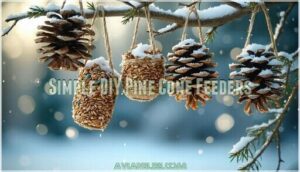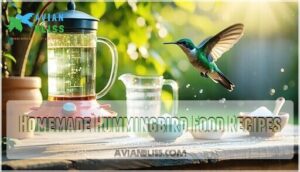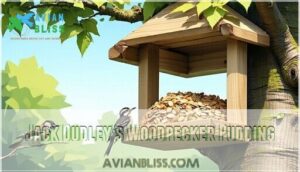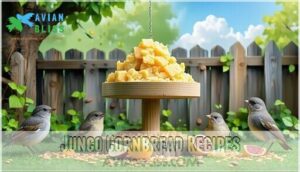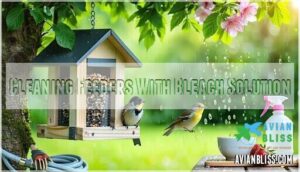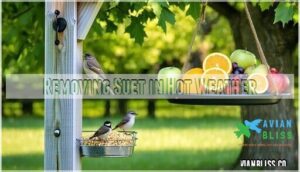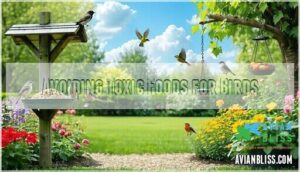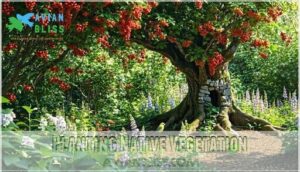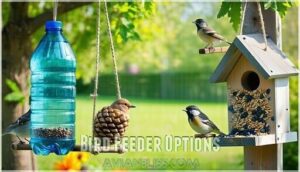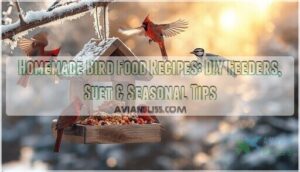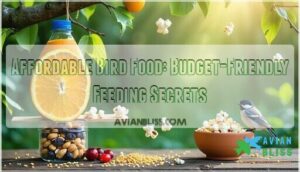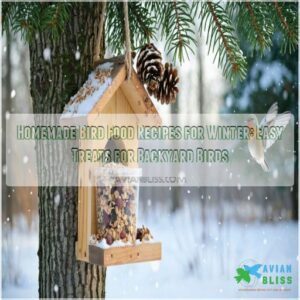This site is supported by our readers. We may earn a commission, at no cost to you, if you purchase through links.
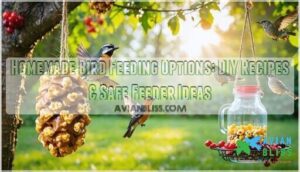 You can create effective homemade bird feeding options using common household items.
You can create effective homemade bird feeding options using common household items.
Spread peanut butter on pine cones, roll them in birdseed, and hang them outside for instant feeders.
Mix birdseed with melted suet or lard to create energy-rich winter bars.
Make hummingbird nectar by combining four parts water with one part sugar – no food coloring needed.
Thread cheerios or popcorn on string for simple garlands.
Use milk jugs or plastic bottles with cut-out holes as DIY feeders.
These budget-friendly solutions attract various bird species while providing essential nutrition year-round.
The key lies in understanding which recipes work best for different seasons and species.
Table Of Contents
- Key Takeaways
- Bird Watching Basics
- Homemade Bird Food
- Bird Feeding Safety
- Bird Feeder Options
- Frequently Asked Questions (FAQs)
- Should you make homemade bird food?
- How to feed birds at home?
- How do you make a homemade bird feeder?
- Can you make homemade bird food without seeds?
- Can You Make your own soft food mix for birds?
- How can you save money on bird food?
- What is a cheap way to feed birds?
- How do you get birds to eat a bird feeder?
- What is a good DIY bird feeder?
- How do you make a free bird feeder?
- Conclusion
Key Takeaways
- You’ll create effective feeders using common items like pine cones, peanut butter, and birdseed for instant, budget-friendly feeding stations that attract multiple species.
- You can make energy-rich winter food by mixing birdseed with suet or lard, and prepare hummingbird nectar using a simple 4:1 water-to-sugar ratio without artificial coloring.
- You’ll save money while providing better nutrition than commercial blends by using kitchen staples like oats, cornmeal, and peanut butter in homemade recipes.
- You must maintain feeder safety by cleaning monthly with bleach solution, removing suet during hot weather, and avoiding toxic foods like chocolate, avocado, and moldy items.
Bird Watching Basics
You can transform your backyard into a bird watching paradise by setting up comfortable viewing spots near windows and creating strategic feeding stations.
Winter feeding provides essential supplemental nutrition when natural food sources become scarce, helping local bird populations survive harsh conditions while giving you front-row seats to observe their fascinating behaviors, making it a great way to enjoy local wildlife.
Creating Comfortable Viewing Spots
Creating the perfect viewing spot transforms your bird watching experience into pure joy. Ideal Placement means positioning yourself where you can observe backyard birds without disturbing their natural behavior patterns.
Window Considerations matter most:
- Seating Options should face your main feeding areas with comfortable back support
- Weather Protection like covered porches keeps you dry during rainy observation sessions
- Camouflage Techniques using earth-toned furniture help you blend into the environment
- Quiet zones minimize sudden movements that startle visiting birds
- Bird feeder placement within 10-15 feet provides ideal viewing distance for detailed observation
This strategic approach to bird attraction creates lasting wildlife connections.
Supplemental Winter Feeding
Winter arrives like an unwelcome guest, bringing food scarcity that threatens your backyard birds’ winter survival.
Natural seeds disappear under snow while insects vanish completely.
Winter bird feeding becomes a lifeline during these harsh months.
Your birds need energy sources packed with fat and protein.
Homemade bird food provides superior nutrition compared to store-bought options.
Suet mixed with seeds offers concentrated calories that fuel their metabolism.
High-quality birdseed blends keep them energized through frigid nights.
Don’t worry about disrupting migration impact – day length, not food availability, triggers their journeys.
Regional needs vary, so northern climates require richer fat content while southern areas need lighter mixes.
Winter bird care means consistent feeding schedules and fresh water sources.
Your efforts literally mean the difference between life and death for local bird populations.
Choosing Right Bird Feeder Types
Now that you’ve established a solid winter feeding routine, selecting the right bird feeder types becomes your next important step. Your feeder material choice directly impacts how well it serves your backyard visitors through harsh weather conditions.
Plastic feeders offer easy cleaning but crack in freezing temperatures. Wood provides natural appeal yet requires regular maintenance to prevent rot. Metal delivers superior weather resistance for year-round bird feeding success.
Size matters when matching feeders to your target bird species. Small songbirds prefer tube-style feeders, while larger birds need platform designs with ample space. **Platform feeders attract ground-feeding birds like cardinals and juncos.
Consider these placement options for ideal results:
- Ground-level platform feeders attract juncos and sparrows
- Hanging tube feeders work perfectly for finches and chickadees
- Suet cages draw woodpeckers and nuthatches during winter months
- Window-mounted feeders provide close-up viewing opportunities
- Homemade bird feeder designs using recycled materials reduce costs substantially
Position your bird feeders 5-10 feet from natural cover. This distance gives birds quick escape routes while keeping predators at bay.
Homemade Bird Food
You’ll find that creating your own bird food mixes saves money while providing better nutrition than many commercial blends filled with cheap fillers.
These simple recipes use common kitchen ingredients to attract specific bird species and support their health throughout the seasons, which is a key aspect of using common kitchen ingredients.
Simple DIY Pine Cone Feeders
Pine cone feeders offer a perfect starting point for backyard bird enthusiasts. Pinecone Selection matters—choose large, fully opened cones like Ponderosa varieties for maximum surface area. Peanut Butter serves as your adhesive base, so spread it generously into every groove and crevice.
Next, Seed Adhesion happens when you roll the coated cone through birdseed, pressing firmly to guarantee coverage. You can find various styles of feeders online.
String Attachment requires tying securely around the cone’s top scales. For Hanging Location, select spots 5-10 feet from cover where birds feel safe. These DIY bird feeders transform simple pine cone crafts into winter lifelines for hungry songbirds.
Homemade Hummingbird Food Recipes
Making hummingbird nectar at home is simpler than you think. Mix one part white sugar with four parts water for perfect nectar ratios. Avoid honey or brown sugar types since they ferment quickly and harm birds.
Boil the water first, dissolve sugar completely, then cool before serving. Skip red dye—it’s unnecessary and potentially toxic.
This sugar water provides essential hydration benefits for nectar-seeking visitors. Storing it properly helps maintain nectar storage freshness.
Store extra nectar in your refrigerator for up to two weeks. Clean feeders every three days in cool weather, daily when it’s hot, to prevent dangerous mold growth.
Jack Dudley’s Woodpecker Pudding
Jack Dudley’s woodpecker pudding creates a rich treat that’ll have birds flocking to your yard. This classic homemade bird food combines peanut butter, suet, oats, and corn syrup into an energy-packed mixture.
The high-fat content provides essential nutritional benefits during cold months, while recipe variations let you customize based on available ingredients. Many recipes on the web, like these diverse ingredients, can be adapted for bird feeding.
- Mix equal parts suet and peanut butter for ideal fat content
- Add rolled oats and corn syrup to create the perfect binding consistency
- Mold into logs or press into wire feeders for easy bird attraction
- Store extra portions in freezer for up to several months
Storage methods include freezing portions for extended use.
Junco Cornbread Recipes
After filling suet feeders for your woodpeckers, you’ll want homemade bird food recipes that attract ground-feeders like juncos.
This bird food combines cornmeal, lard, and crushed eggshells for Nutritional Benefits.
Baking Techniques at 350°F create perfect crumbly texture.
Recipe Variations include adding bird food ingredients like dried fruits or seeds.
Storage Tips: keep cooled cornbread refrigerated.
Crumble into feeders for cost-effective bird feeding recipes that outperform expensive birdseed mixes.
Bird Feeding Safety
Proper bird feeding safety protects both you and your feathered visitors from potential health risks.
You’ll need to follow specific cleaning schedules and food guidelines to create a safe feeding environment that keeps birds healthy year-round, ensuring complete concepts of bird care are considered.
Cleaning Feeders With Bleach Solution
How often should you sanitize your feeders to keep your feathered friends healthy? Regular cleaning prevents disease transmission and keeps birds coming back safely.
Bleach concentration should be 10% for effective bacteria control and mold prevention. Mix one part bleach with nine parts water for safe handling.
Follow these essential steps for proper feeder sanitation:
- Remove old food and scrub with warm soapy water first
- Soak in bleach solution for exactly ten minutes maximum
- Rinse thoroughly with clean water to eliminate chemical residue
- Air-dry completely before refilling with fresh seed
Clean feeders monthly for ideal bird feeding safety. Alternative disinfectants like white vinegar work well too, reducing environmental impact while maintaining feeder hygiene.
Removing Suet in Hot Weather
Temperature thresholds matter when hot weather feeding becomes risky for birds.
Suet spoilage occurs rapidly when temperatures exceed 70°F, creating messy conditions that attract unwanted pests.
You’ll need to remove suet feeders completely during summer months to maintain safe bird feeding practices.
Switch to alternative foods like sunflower seeds or fresh fruit for seasonal feeding.
Clean any melted residue thoroughly before storing suet until cooler weather returns for your homemade bird food rotation.
Avoiding Toxic Foods for Birds
Protecting your feathered visitors requires knowing which everyday items can harm them. Many common household foods pose serious threats to bird health and wellbeing.
Avocado Toxicity tops the danger list—all parts contain persin, causing heart failure within hours. Chocolate Risks and Caffeine Dangers stem from theobromine and caffeine, which trigger seizures and cardiac arrest in birds. Alcohol Harm occurs rapidly, as birds process alcohol differently than mammals, leading to liver damage from tiny amounts.
Here are five toxic foods for birds you must avoid:
- Moldy foods – cause organ failure and respiratory infections
- Salt-heavy snacks – lead to dehydration and kidney problems
- Onions and garlic – destroy red blood cells, causing anemia
- Fruit pits – contain cyanide that’s deadly to birds
- Dairy products – birds can’t digest lactose properly
Safe bird food alternatives include black oil sunflower seeds, unsalted nuts, and fresh fruits without pits. A balanced diet requires essential vitamins and minerals for ideal health. Always choose birdsafe ingredients over kitchen scraps.
Planting Native Vegetation
Beyond avoiding toxic foods, you can create lasting bird habitat through native plant choices.
Native Plant Benefits include year-round food sources and natural shelter.
These birdfriendly plants support Local Ecosystem Support while Reducing Lawn maintenance needs.
| Plant Type | Bird Benefits | Seasonal Value |
|---|---|---|
| Native Sunflowers | Seed production for finches | Late summer/fall harvest |
| Berry Bushes | Fruit for thrushes, waxwings | Spring through winter food |
| Native Grasses | Nesting material, insect habitat | Year-round cover and seeds |
| Wildflower Meadows | Attracts insects birds eat | Seasonal Blooms support diversity |
| Oak Trees | Acorns, caterpillar host plants | Multi-season natural resources for birds |
Habitat Creation through native vegetation meets bird habitat requirements better than feeders alone, supporting bird species diversity in your backyard bird attracting efforts.
Bird Feeder Options
You can create effective bird feeders using everyday materials found around your home, from plastic bottles to pine cones.
These DIY options let you customize feeding stations while saving money compared to store-bought alternatives, using everyday materials and DIY options.
Hanging and Standing Feeder Types
Multiple feeder types transform your backyard into a bustling bird haven. Hanging bird feeders and platform bird feeders work together perfectly to attract different species at various feeding levels.
Transform your yard into a bird paradise with strategic feeder placement and diverse feeding stations.
Smart Feeder Placement creates the foundation for success:
- Material Durability – Select cedar wood or recycled plastic that withstands harsh weather conditions
- Capacity Considerations – Choose larger feeders for busy neighborhoods with many birds
- Weather Resistance – Add proper drainage and protective roofs to prevent seed spoilage
- Aesthetic Appeal – Design DIY bird feeders that complement your garden’s natural beauty
Squirrel proof feeders require strategic positioning five feet from jumping surfaces. Recycled bird feeders offer budget-friendly solutions while supporting sustainability goals.
Tree-Mounted and Window Feeders
Transform your backyard into a bird-watching haven with strategic tree mounting and window feeder placement.
Tree mounting requires selecting sturdy trunks at least 6 inches in diameter, positioning your homemade bird feeders 5-6 feet high for ideal bird visibility while ensuring easy access for refilling.
Window bird feeders offer unmatched viewing opportunities, but window safety remains paramount.
Position feeders either within 3 feet of windows or more than 30 feet away to prevent collisions.
| Feeder Type | Ideal Height |
|---|---|
| Tree-mounted | 5-6 feet |
| Window suction | Eye level |
| Platform style | 4-5 feet |
Proper feeder placement considers escape routes to nearby cover.
Birds need quick access to shrubs or trees when predators appear.
South-facing windows provide excellent bird feeding spots during winter months, maximizing sunlight exposure.
Remember that consistent placement builds trust with visiting birds, encouraging regular visits to your homemade bird feeding station, creating a bird feeding station that attracts a variety of species.
Squirrel-Proofing Feeders
While squirrels might seem like charming acrobats, they’ll devour your bird food faster than you can refill feeders.
Squirrelproof feeders use smart engineering to solve this problem. Weight activation mechanisms close seed ports when heavier animals climb on, while cage feeders surround food with metal bars that allow birds through but block squirrels.
Baffle designs create slippery barriers on poles that squirrels can’t climb. These dome or cylinder-shaped guards mount below feeders and eliminate 70-80% of climbing attempts when properly installed.
Feeder placement proves equally important. Position your bird feeder at least ten feet from trees, fences, or structures squirrels use as launching points. Consider exploring different feeder product options for your yard.
Combine this with pole-mounted baffles for maximum pest prevention against unwanted creatures while maintaining bird food safety.
Using Recycled Materials
Beyond squirrel deterrents, you’ll find cost-effective solutions by repurposing household items. DIY bird feeders from plastic bottle feeders and milk carton feeders work beautifully. These eco-friendly designs help the environment while attracting feathered friends.
Recycled bird feeders also offer unique design opportunities, allowing for creative and personalized avian habitats.
Here’s what transforms trash into treasure:
- Upcycled can feeders with drainage holes prevent seed spoilage
- Natural material feeders using pinecones decompose safely outdoors
- Homemade bird feeder projects from toilet paper rolls coat easily with homemade birdseed
These upcycled bird feeders prove that bird feeders don’t require expensive store purchases.
Frequently Asked Questions (FAQs)
Should you make homemade bird food?
Like a chef crafting a perfect recipe, you’ll save money and provide better nutrition when making homemade bird food.
You’ll avoid cheap fillers, attract more species, and create energy-rich meals that help birds survive harsh winters.
How to feed birds at home?
Set up feeders 5-10 feet from cover, fill with quality seeds, nuts, or suet. Clean weekly with soapy water, provide fresh water nearby, and avoid bread or chocolate.
How do you make a homemade bird feeder?
You’ll need a pine cone, peanut butter, and birdseed. Tie string around the cone’s top, coat it with peanut butter, roll in seeds, and hang outside for birds to enjoy.
Can you make homemade bird food without seeds?
You can make nutritious homemade bird food using peanut butter, oats, cornmeal, and dried fruits.
Mix these with lard or shortening to create suet cakes that provide essential fats and energy for winter birds.
Can You Make your own soft food mix for birds?
Forget what you’ve heard about complicated bird recipes – you’ll actually create soft food mixes using everyday pantry staples like oats, cornmeal, peanut butter, and mashed fruit for perfect bird nutrition.
How can you save money on bird food?
You’ll slash bird food costs by making homemade mixes using kitchen staples like peanut butter, oats, and sunflower seeds instead of buying expensive commercial blends.
What is a cheap way to feed birds?
Picture a savvy grandma stretching her grocery budget – she knows homemade beats store-bought every time.
You’ll slash bird food costs by mixing peanut butter with oats, seeds, and cornmeal from your pantry, creating nutritious meals for just pennies per serving.
How do you get birds to eat a bird feeder?
Place feeders near natural cover like bushes or trees, keep them consistently filled with fresh seed, and position them 5-10 feet from shelter for safety.
What is a good DIY bird feeder?
Simple pine cone feeders work wonderfully.
You’ll coat pine cones with peanut butter, roll them in birdseed, then hang using string loops.
They’re inexpensive, attract multiple species, and you can make them with kids easily.
How do you make a free bird feeder?
You’ll create a free bird feeder using household items like pine cones, toilet paper rolls, or plastic bottles.
Simply coat with peanut butter, roll in seeds, and hang outside to attract birds.
Conclusion
Studies show backyard birds visit feeders up to 20 times daily during winter months.
Successfully implementing homemade bird feeding options requires understanding seasonal needs and species preferences.
You’ve learned to create pine cone feeders, mix hummingbird nectar, and build DIY feeders from recycled materials.
Remember to clean feeders regularly and remove suet during hot weather.
Your consistent efforts with these budget-friendly solutions will attract diverse bird species while providing essential nutrition throughout the year.
- https://letgrow.org/diy-bird-feeder/
- https://www.nhm.ac.uk/discover/how-to-make-a-bird-feeder.html
- https://underatinroof.com/blog/how-to-make-homemade-suet-for-birds
- https://runwildmychild.com/easy-bird-feeders-with-kids/
- https://www.plt.org/educator-tips/bird-feeder-projects-natural-recycled-materials/

